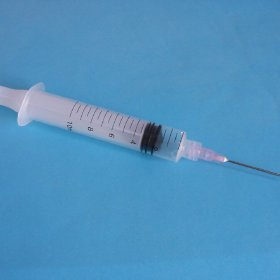
Generation Narcan
Originally published in The Weekly Standard
In an iconic scene in Pulp Fiction, Uma Thurman's character, Mia, overdoses on heroin and is revived by the administration of an adrenaline injection to the heart.
While not exactly accurate from a medical standpoint—opiates suppress one's respiratory drive, they don't cause cardiac arrest—resurrections such as the one Mia experienced are playing out hundreds of times a day all across America. Ambulance personnel, police, and even citizens administer Narcan, a quick-acting antidote usually administered as a spray into the nostrils that shoves opiate molecules off receptors in the brain, to individuals in the midst of an overdose.
The number of heroin users tripled between 2007 and 2014 to more than 435,000 users that year. Accordingly, heroin overdose deaths have spiked over 400 percent in that same period, rising to some 10,500 in 2014 per the Centers for Disease Control and Prevention (CDC). If you total overdoses from all opioids, the death toll in 2014 was nearly 30,000.
According a 2012 study by the CDC, Narcan successfully reversed ten thousand likely fatal overdoses between 1996 and 2010. Although more recent aggregate data are not available, evidence suggests that with the rise in heroin use and resulting overdoses, Narcan has saved overdose victims tens of thousands more times in the years since.
This is an especially acute issue with the latest news that a new opioid variant, fentanyl, which is 50 to 100 times stronger than heroin, is entering the American drug market.
That drug, we now know, was likely responsible for the death of Prince, and contributed to the deaths of thousands of others.
Like Prince, many who are taking fentanyl are unaware they are even consuming the powerful opiate, since its being added to counterfeit prescription drugs and street heroin. Dealers and traffickers are bringing in the drug and its precursors from China and Mexico and mixing it in with their wares to increase its potency and their profit.
A kilogram of fentanyl can be acquired from producers for $3,500, but earns drug pushers much more since it can be diluted and still be stronger than heroin. The street value of that fentanyl ranges from $6 million to $13 million —more than ten times what traditional heroin would earn them.
Troublingly, fentanyl's potency limits the effects of Narcan, sometimes requiring multiple doses to revive an overdose victim.
With fentanyl now more prevalent, overdose deaths are likely to increase as they already have in heroin-laden states like New Hampshire where fentanyl now comprises 71.5 percent of all opioid overdose deaths. But analysis of CDC records shows that the epidemic is not localized, deaths from overdoses are rising rapidly, particularly in rural areas.
The trend line suggests that 2015 and 2016 rates of overdose will only increase dramatically, year-on-year.
Narcan is doing something remarkable: reviving drug abusers and giving them back their lives. It's a true "second chance" drug that is creating a new generation of resurrected overdose victims. This is "Generation Narcan," as the American Enterprise Institute scholar and addiction specialist Sally Satel terms it.
Although the opioid overdose reversal elixir has been available since 1961 it has never been as widely used and available as it is today. Narcan's accessibility to medical professionals and first responders should be encouraged and applauded. But making the miracle drug widely accessible does nothing to arrest the opioid epidemic or reduce the amount of dependence.
But while Narcan saves lives, it does little to combat addiction, the very problem that can lead to overdoses. Therefore, in addition to curbing the supply and availability of dangerous drugs, we must also put in place serious treatment options for this new generation of surviving overdose victims.
Narcan is doing something remarkable: reviving drug abusers and giving them back their lives. It's a true "second chance" drug that is creating a new generation of resurrected overdose victims. This is "Generation Narcan," as the American Enterprise Institute scholar and addiction specialist Sally Satel terms it.
Although the opioid overdose reversal elixir has been available since 1961 it has never been as widely used and available as it is today. Narcan's accessibility to medical professionals and first responders should be encouraged and applauded. But making the miracle drug widely accessible does nothing to arrest the opioid epidemic or reduce the amount of dependence.
But while Narcan saves lives, it does little to combat addiction, the very problem that can lead to overdoses. Therefore, in addition to curbing the supply and availability of dangerous drugs, we must also put in place serious treatment options for this new generation of surviving overdose victims.
Since Narcan administration generally involves medical personnel or first responders, survivors should be immediately identified before they leave the sight of authorities and be encouraged to enter treatment or face the civil and criminal consequences. Addicts are not beyond reason and compelled treatment is no panacea but the government has an interest in ensuring they re-enter society as fully functioning, productive and autonomous citizens.
Drug addiction limits their ability to make rational decisions and our interests (and theirs) are best served by seeing them well again.
It will certainly cost a great deal of money, but opioid addiction's rising direct and indirect costs to the economy and taxpayers via lost productivity, crime, and healthcare are already stagger
With more powerful and deadlier opioid variants and the huge jump in opioid use, the cost of this terrible addiction is likely much higher.
When it comes to Generation Narcan, we must act to both save their lives and restore their promise as people.
Sean Kennedy is a Visiting Fellow at the Maryland Public Policy Institute, a nonpartisan think tank.






